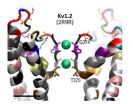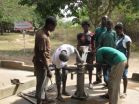(Press-News.org) DURHAM, N.C. -- When you accidentally touch a hot oven, you rapidly pull your hand away. Although scientists know the basic neural circuits involved in sensing and responding to such painful stimuli, they are still sorting out the molecular players.
Duke researchers have made a surprising discovery about the role of a key molecule involved in pain in worms, and have built a structural model of the molecule. These discoveries, described Sept. 2 in Nature Communications, may help direct new strategies to treat pain in people.
In humans and other mammals, a family of molecules called TRP ion channels plays a crucial role in nerve cells that directly sense painful stimuli. Researchers are now blocking these channels in clinical trials to evaluate this as a possible treatment for various types of pain.
The roundworm Caenorhabditis elegans also expresses TRP channels -- one of which is called OSM-9 -- in its single head pain-sensing neuron (which is similar to the pain-sensing nerve cells for the human face). OSM-9 is not only vital for detecting danger signals in the tiny worms, but is also a functional match to TRPV4, a mammalian TRP channel involved in sensing pain.
In the new study, researchers created a series of genetic mutant worms in which parts of the OSM-9 channel were disabled or replaced and then tested the engineered worms' reactions to overly salty solution, which is normally aversive and painful.
Specifically, the mutant worms had alterations in the pore of the OSM-9 channels in their pain-sensing neuron, which gets fired up upon channel activation to allow calcium and sodium to flow into the neuron. That, in turn, was thought to switch on the neural circuit that encodes rapid withdrawal behavior -- like pulling the finger from the stove.
"People strongly believed that calcium entering the cell through the TRP channel is everything in terms of cellular activation," said lead author Wolfgang Liedtke, M.D., Ph.D., an associate professor of neurology, anesthesiology and neurobiology at Duke University School of Medicine and an attending physician in the Duke Pain Clinics, where he sees patients with chronic head-neck and face-pain.
With then-graduate student Amanda Lindy, "we wanted to systemically mutagenize the OSM-9 pore and see what we could find in the live animal, in its pain behavior," Liedtke said.
To the group's surprise, changing various bits of OSM-9's pore did not change most of the mutant worms' reactions to the salty solution. However, these mutations did affect the flow of calcium into the cell. The disconnect they saw suggested the calcium was not playing a direct role in the worms' avoidance of danger signals.
Calcium has been thought to be indispensable for pain behavior -- not only in worms' channels but in pain-related TRP channels in mammals. So results from the engineered OSM-9 mutant worms will change a central concept for the understanding of pain, Liedtke said.
To see whether calcium might instead play a role in the worms' ability to adapt to repeated painful stimuli, the group then repeatedly exposed pore-mutant worms to the aversive and pain stimuli.
After the tenth trial, a normal worm becomes less sensitive to high salt. But one mutant worm with a minimal change to one specific part of its OSM-9 pore -- altered so that calcium no longer entered but sodium did -- was just as sensitive on the tenth trial as on the first.
The results confirmed that calcium flow through the channel makes the worms more adaptable to painful stimuli; it helps them cope with the onslaught by desensitizing them. This could well represent a survival advantage, Liedtke said.
To put the findings into a structural context, Liedtke collaborated with computational protein scientists Damian van Rossum and Andriy Anishkin from Penn State University, who built a structural model of OSM-9 that was based on established structures of several of the channel's relatives, including the recently resolved structure of TRPV1, the molecule that senses pain caused by heat and hot chili peppers.
The team was then able to visualize the key parts of the OSM-9 pore in the context of the entire channel. They understood better how the pore holds its shape and allows sodium and calcium to pass.
Liedtke said that understanding this structure could be a great help in designing compounds that will not completely block the channel but will just prevent calcium from entering the cell. Although calcium helps desensitize worms to painful stimuli in the near term, it might set up chronic, pathological pain circuits in the long term, Liedtke said.
So, as a next step, the group plans to assess the longer-term effects calcium flow has in pain neurons. For example, calcium could change the expression of particular genes in the sensory neuron. And such gene expression changes could underlie chronic, pathologic pain.
"We assume, and so far the evidence is quite good, that chronic, pathological pain has to do with people's genetic switches in their sensory system set in the wrong way, long term. That's something our new worm model will now allow us to approach rationally by experimentation," Liedtke said.
INFORMATION:
This work was supported by the Esther A. and Joseph Klingenstein Fund, the Whitehall Foundation, start-up funds from Duke University, and grants from the National Science Foundation (428-15 691M) and the National Institutes of Health (GM087410-01).
CITATION: "TRPV-channel-mediated calcium-transients in nociceptor neurons are dispensable for avoidance behavior," Amanda S. Lindy, Puja K. Parekh, Richard Zhu, Patrick Kanju, Sree V. Chintapalli, Volodymyr Tsvilovskyy, Randen L. Patterson, Andriy Anishkin, Damian B. van Rossum, Wolfgang B. Liedtke. Nature Communications, Sept. 2, 2014
Surprising new role for calcium in sensing pain
Flow through pain-sensing molecule helps worms adapt to pain
2014-09-02
ELSE PRESS RELEASES FROM THIS DATE:
Single laser stops molecular tumbling motion instantly
2014-09-02
In the quantum world, making the simple atom behave is one thing, but making the more complex molecule behave is another story.
Now Northwestern University scientists have figured out an elegant way to stop a molecule from tumbling so that its potential for new applications can be harnessed: shine a single laser on a trapped molecule and it instantly cools to the temperature of outer space, stopping the rotation of the molecule.
"It's counterintuitive that the molecule gets colder, not hotter when we shine intense laser light on it," said Brian Odom, who led the research. ...
NYU study compares consequences of teen alcohol and marijuana use
2014-09-02
Growing public support for marijuana legalization in the U.S. has led to public debate about whether marijuana is "safer" than other substances, such as alcohol. In January, President Obama also publically stated he is not convinced that marijuana is more dangerous than alcohol. Despite the recent shift in views toward marijuana, the harms of use as compared to alcohol use are not well understood.
Now a new study "Adverse Psychosocial Outcomes Associated with Drug Use among US High School Seniors: A Comparison of Alcohol and Marijuana," by researchers affiliated with ...
Discovery hints at why stress is more devastating for some
2014-09-02
Some people take stress in stride; others are done in by it. New research at Rockefeller University has identified the molecular mechanisms of this so-called stress gap in mice with very similar genetic backgrounds — a finding that could lead researchers to better understand the development of psychiatric disorders such as anxiety and depression.
"Like people, each animal has unique experiences as it goes through its life. And we suspect that these life experiences can alter the expression of genes, and as a result, affect an animal's susceptibility to stress," says senior ...
Simple awareness campaign in general practice identifies new cases of AF
2014-09-02
Barcelona, Spain – Tuesday 2 September 2014: A simple awareness campaign in general practice identifies new cases of atrial fibrillation (AF), according to research presented at ESC Congress today by Professor Jean-Marc Davy from France.
Professor Davy said: "Atrial fibrillation (AF) is the most common cardiac arrhythmia. It multiplies the risk of heart failure risk by three-fold and the risk of stroke risk by five-fold. Similarly, AF is responsible for ischaemic stroke in 1 of 4 cases. However, AF is often overlooked and diagnosed too late. In 20% of cases, AF is diagnosed ...
ROCKET AF trial suggests that digoxin increases risk of death in AF patients
2014-09-02
Barcelona, Spain – Tuesday 2 September 2014: Digoxin may increase the risk of death in patients with atrial fibrillation (AF) by approximately 20%, according to results from the ROCKET AF trial presented at ESC Congress today by Dr Manesh Patel, director of interventional cardiology and catheterisation labs at Duke University Health System in Durham, North Carolina, US. The findings suggest that caution may be needed when using digoxin in complex AF patients but further studies are needed to confirm the observations.
Dr Patel said: "In this subanalysis of the ROCKET AF ...
Health structures explain nearly 20 percent of non-adherence to heart failure guidelines
2014-09-02
Barcelona, Spain – Tuesday 2 September 2014: Health structures explain nearly 20% of the non-adherence to heart failure guidelines, according to the results of a joint ESC-OECD study presented today at ESC Congress by Professor Aldo Maggioni. Clinical variables explained more than 80% of non-adherence.
Professor Maggioni said: "This is a unique evaluation which combines clinical data and health structure characteristics of different countries. It provides a fuller picture of the reasons some patients with heart failure do not receive treatment according to ESC guidelines."
Heart ...
Mechanical heart valves increase pregnancy risk
2014-09-02
Barcelona, Spain – Tuesday 2 September 2014: The fact that mechanical heart valves increase risks during and after pregnancy, has been confirmed by data from the ROPAC registry presented for the first time today in an ESC Congress Hot Line session by Professor Jolien W. Roos-Hesselink, co-chair with Professor Roger Hall of the registry's executive committee. The registry found that 1.4% of pregnant women with a mechanical heart valve died and 20% lost their baby during pregnancy.
The Registry Of Pregnancy And Cardiac disease (ROPAC) is an ongoing worldwide registry that ...
The key to drilling wells with staying power in the developing world
2014-09-02
What happens after a well is drilled, fitted with a hand pump, and a community celebrates having access to clean water for the first time? Half of them break down in a year.
When a community lacks sufficient resources and training, these wells would be rendered unusable; however, a new study by the University of North Carolina-Chapel Hill's (UNC) Water Institute and Water and Sanitation for Africa, a Pan-African humanitarian agency, found that if local water communities collect fees for repairs and train community members to fix the wells, they can remain in use for ...
Cannabis withdrawal symptoms common among adolescents treated for substance use disorder
2014-09-02
Although cannabis – commonly known as marijuana – is broadly believed to be nonaddictive, a study by Massachusetts General Hospital (MGH) investigators found that 40 percent of cannabis-using adolescents receiving outpatient treatment for substance use disorder reported experiencing symptoms of withdrawal, which are considered a hallmark of drug dependence. Study participants reporting withdrawal were more likely to meet criteria for severe substance use and for mood disorders, although the presence or absence of withdrawal did not appear to change long-term treatment ...
WSU 'deadly force' lab finds racial disparities in shootings
2014-09-02
SPOKANE, Wash.—Participants in an innovative Washington State University study of deadly force were more likely to feel threatened in scenarios involving black people. But when it came time to shoot, participants were biased in favor of black suspects, taking longer to pull the trigger against them than against armed white or Hispanic suspects.
The findings, published in the recent Journal of Experimental Criminology, grow out of dozens of simulations aimed at explaining the disproportionate number of ethnic and racial minorities shot by police. The studies use the most ...
LAST 30 PRESS RELEASES:
Longest observation of an active solar region
Why nail-biting, procrastination and other self-sabotaging behaviors are rooted in survival instincts
Regional variations in mechanical properties of porcine leptomeninges
Artificial empathy in therapy and healthcare: advancements in interpersonal interaction technologies
Why some brains switch gears more efficiently than others
UVA’s Jundong Li wins ICDM’S 2025 Tao Li Award for data mining, machine learning
UVA’s low-power, high-performance computer power player Mircea Stan earns National Academy of Inventors fellowship
Not playing by the rules: USU researcher explores filamentous algae dynamics in rivers
Do our body clocks influence our risk of dementia?
Anthropologists offer new evidence of bipedalism in long-debated fossil discovery
Safer receipt paper from wood
Dosage-sensitive genes suggest no whole-genome duplications in ancestral angiosperm
First ancient human herpesvirus genomes document their deep history with humans
Why Some Bacteria Survive Antibiotics and How to Stop Them - New study reveals that bacteria can survive antibiotic treatment through two fundamentally different “shutdown modes”
UCLA study links scar healing to dangerous placenta condition
CHANGE-seq-BE finds off-target changes in the genome from base editors
The Journal of Nuclear Medicine Ahead-of-Print Tip Sheet: January 2, 2026
Delayed or absent first dose of measles, mumps, and rubella vaccination
Trends in US preterm birth rates by household income and race and ethnicity
Study identifies potential biomarker linked to progression and brain inflammation in multiple sclerosis
Many mothers in Norway do not show up for postnatal check-ups
Researchers want to find out why quick clay is so unstable
Superradiant spins show teamwork at the quantum scale
Cleveland Clinic Research links tumor bacteria to immunotherapy resistance in head and neck cancer
First Editorial of 2026: Resisting AI slop
Joint ground- and space-based observations reveal Saturn-mass rogue planet
Inheritable genetic variant offers protection against blood cancer risk and progression
Pigs settled Pacific islands alongside early human voyagers
A Coral reef’s daily pulse reshapes microbes in surrounding waters
EAST Tokamak experiments exceed plasma density limit, offering new approach to fusion ignition
[Press-News.org] Surprising new role for calcium in sensing painFlow through pain-sensing molecule helps worms adapt to pain





